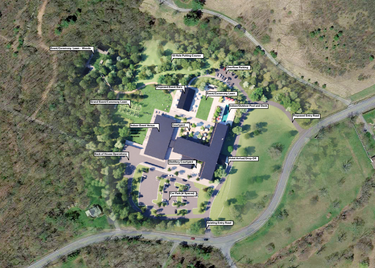Inns of Altamont proposal supported by neighbors voicing requests
GUILDERLAND — While Guilderland Zoning Board of Appeals members cited issues with traffic and water and neighbors brought up potential lighting and trespassing concerns, the proposed Inns of Altamont was generally well received during the zoning board’s Oct. 16 meeting and appears to be on the path to approval.
The board OK’d the concept, allowing it to be sent to the village of Altamont’s rural referral committee, which, due to a 2005 law, gets to weigh in on actions to real property within 1,200 feet of the village boundary, or 1,200 feet from a current or future Altamont water system.
The Inns of Altamont project is due back before the zoning board for its December meeting.
The 16-acre property sits on the shoulder of the Helderberg escarpment overlooking the village of Altamont.
Project developer Kent Hansen is proposing to turn the former Peter Young Center into a 30-room hotel with a 45-seat restaurant and multiple event spaces, both indoor and outdoor.
Board member Sharon Cupoli said, “I drove [there] today to check it out, and I thought, ‘Boy, coming out of there is going to be a tough nut to do.’” The town’s planning board during its review of the proposal cited similar concerns.
Project engineer Luigi Palleschi responded that the entrance was “tricky,” but said it could be moved. “By moving it, we’ll make that safer,” he said.
But it was noted that Berne-Altamont Road is a state road and Palleschi would have to get the state’s Department of Transportation to sign off on moving the entrance.
“And what happens if you don't get permission, though?” zoning board Chairwoman Elizabeth Lott asked.
Palleschi responded, “Well, that's something we’re going to have to work out with DOT. If it’s not in this exact location and we have to slide it 20 feet or 30 feet one way or the other to satisfy DOT, we’ll have to do that.”
There was also a concern over the number of parking spots provided, 181, which is 12 fewer than code calls for.
Palleschi reasoned that, “because of the mixed use that is presented here,” it’s likely that a number of event-goers would be staying at the hotel. “So you can almost count those spaces as double spaces.”
Providing potable water to the site has been a concern cited by various entities since the project was first made public, in July.
Asked about the issue, the board was told the village of Altamont, which recently received some potentially good news about its water system, has said it could provide up to 5,000 gallons of potable water per day.
A on-site tank able to hold 5,000 additional gallons would be installed as a backup for when the hotel and event space go over their daily allotment, which is likely to happen the board was told. As for fire protection, underground storage tanks would be installed.
William Johnson, whose home is located across the street from the proposed project, told board members, “We’ve been in our home for 38 years. We’ve been slowly and meticulously restoring our home. It’s now essentially done … We plan to continue to stay here.”
Johnson said he was in favor of the project and that the property, “frankly,” has been “an eyesore for the time we’ve been living here,” but he also has some concerns.
“We’d like to see a cap on the maximum number of attendees at events,” said Johnson, adding “We’d like to see some sort of a noise curfew in the special-use permit so that if there was an outdoor wedding, for example.”
He went on, “The final thing is lighting.”
Johnson said his very-windowed bedroom is in the front of his house, facing the proposed hotel, so “we would hope that the lighting would be of the type that is diffuse and aimed downward.”
Robert Digeser, another Berne-Altamont Road resident who owns 90 acres surrounding the former Peter Young Center, said he wasn’t against the proposal — “I think it’s a great idea,” he said — but he was concerned that there could be event-goers who find their way onto his land.
“There are trails on my property that are beyond beautiful that lead to many crevasses, a waterfall,” he said. “I’m very concerned that you guys and I have guests that are going to be drinking, they’re going to wander off on these trails that are very accessible. That’s a concern of mine.”
Fran Porter wanted to bring to everyone’s attention potential problems for just getting to the proposed venue.
“Altamont will have long trains coming through the village,” said Porter, adding that Norfolk Southern will be operating “long trains, something approaching two miles long. So with that length, that could possibly tie up all three entrances into Altamont simultaneously. So that again is not within our purview of fixing. Nobody can stop the trains. But again, it is a consideration to kind of think about because if you’re waiting for those trains.”
Altamont water
During the September meeting of the Altamont Village Board, trustees were told of a potential solution to a water-quality problem at one of its well sites.
Engineer Rich Straut, who is also the mayor of neighboring Voorheesville, came to update the board on the village’s long-running issue with manganese in the Brandle Road water supply.
In October, Straut had recommended that Altamont study the introduction of potassium ferrate into the drinking water at the Brandle Road site since the village had been notified in February 2022 that its levels of manganese were at or above the benchmark set by the federal Environmental Protection Agency.
The village shut down the Brandle Road wellsite, which, when operating, produces about a third of its drinking water supply, and has largely kept it shut save for periods of peak usage, at which point the Brandle Road supply gets mixed into the village’s other water supply, from Gun Club Road; the village also has to notify customers when it plans to use Brandle Road
In October of last year, trustees approved $20,000 to study the efficacy of introducing potassium ferrate into the water supply, which could potentially solve the manganese issue.
Straut said at the time, “We found out that it was very effective.”
But the issue a year ago was the company that made the potassium ferrate couldn’t produce the potential solution on a commercial level.
Straut told the village board this month he was about to move on from using the chemical when he learned that Holland Chemical is in talks with the maker of potassium ferrate, Element 26, to produce the new formulation commercially.
Straut said he had an upcoming meeting with Holland and Element 26 to “talk about the commercialization and to start getting a sense of whether this is real. Are they actually going to be able to commercialize this? Will you be able to get a reliable continuous supply?”
If it turns out that production is possible, Straut made a tentative recommendation that the village go the potassium ferrate route rather than the more-expensive green-sand filtration system.
While Straut didn’t offer a figure for the preferred filtration method, he did say it was “much less expensive” than the alternative, whose filters alone were estimated at about $500,000.



